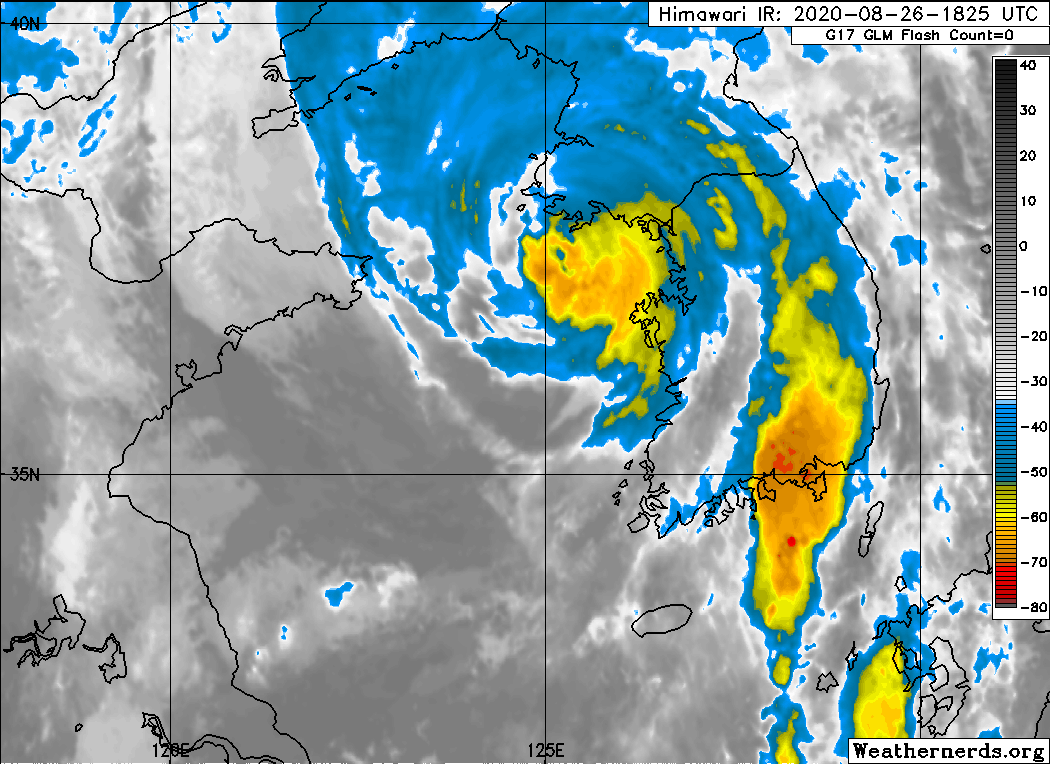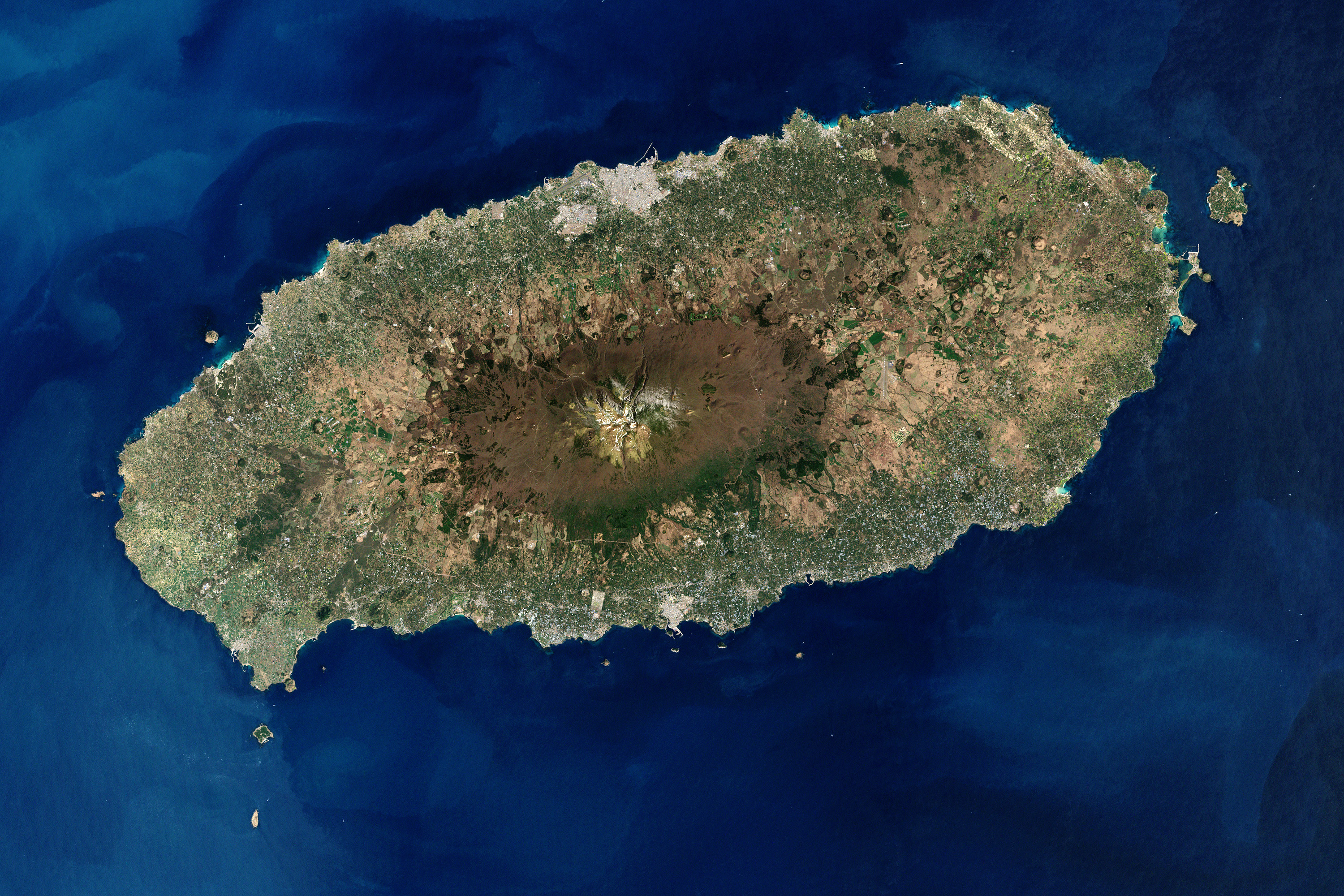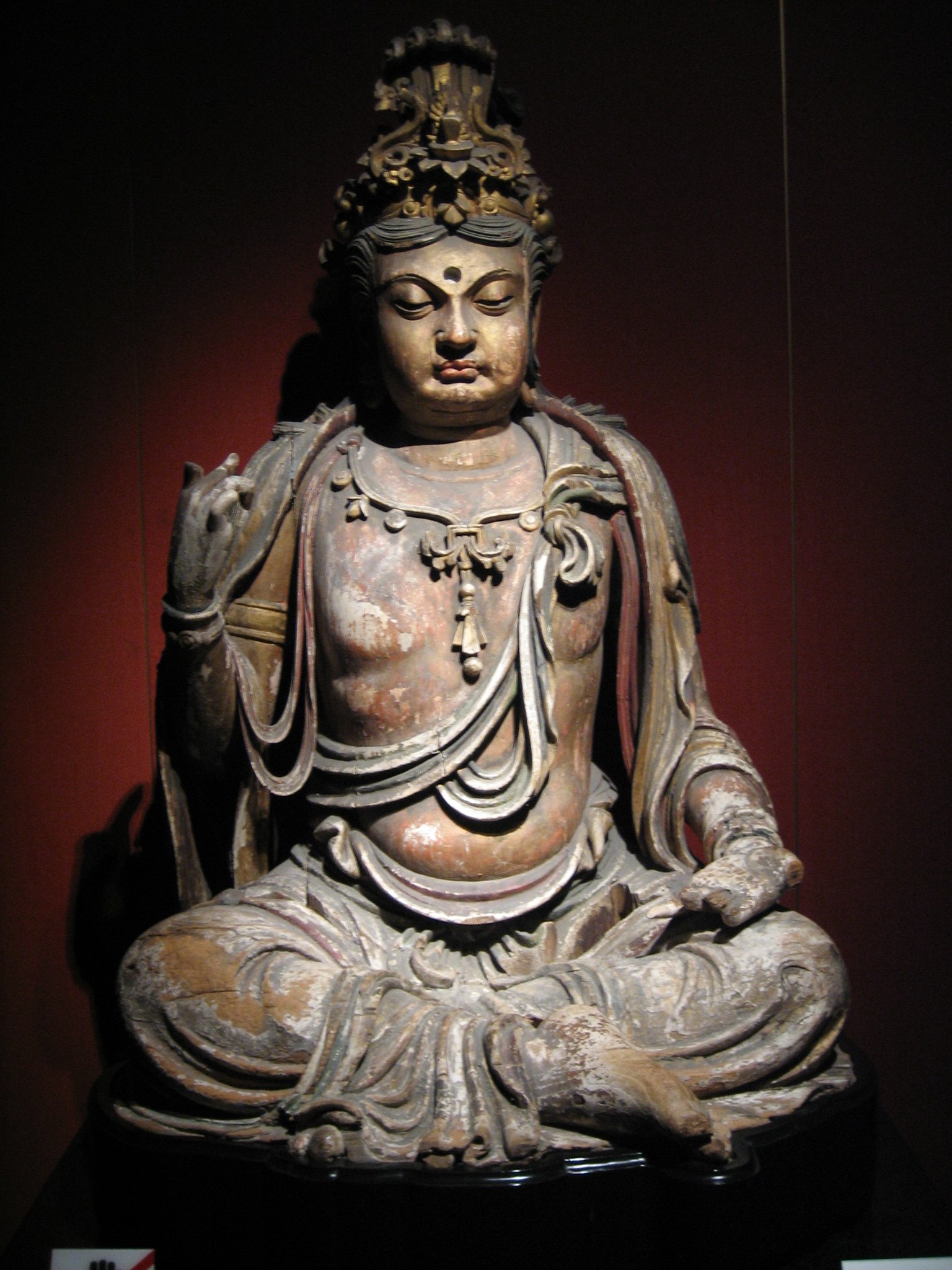|
Typhoon Bavi (other)
Typhoon Bavi (transliterated from Vietnamese Ba Vì), known in the Philippines as Severe Tropical Storm Igme, was a powerful tropical cyclone that made landfall in North Korea in late August 2020. The eighth named storm and third typhoon of the 2020 Pacific typhoon season, Bavi formed from a low pressure area depression on August 21 to the north of the Philippines and strengthened into a tropical storm on August 22. Bavi gradually strengthened as it skirted Taiwan and Okinawa, and became a typhoon on August 24. Passing over warm waters, Bavi turned to northwest and reached its peak intensity near Jeju Island on August 26. Thereafter, increasing wind shear and cooler waters caused Bavi to quickly weaken. Bavi made landfall in North Korea on August 27, and became an extratropical cyclone shortly thereafter. Bavi caused minimal damage in portions of South Korea and Japan, but caused widespread structural damage and flooding in North Korea. It was the first storm in two weeks span to ... [...More Info...] [...Related Items...] OR: [Wikipedia] [Google] [Baidu] |
Jeju Island
Jeju Island (Jeju language, Jeju/) is South Korea's largest island, covering an area of , which is 1.83% of the total area of the country. Alongside outlying islands, it is part of Jeju Province and makes up the majority of the province. The island lies in the Korea Strait, south of the nearest point on the Korean Peninsula. The Jeju people are indigenous to the island, and it has been populated by modern humans since the early Neolithic, Neolithic period. The Jeju language is considered critically endangered by UNESCO. It is also one of the regions of Korea where Korean shamanism, Shamanism is most intact. Jeju Island has an oval shape and is east–west and north–south, with a gentle slope around Hallasan in the center. The length of the main road is and the coastline is . On the northern end of Jeju Island is Gimnyeong Beach, on the southern end Songaksan (Jeju), Songak Mountain, the western end Suwolsan, Suwol Peak, and the eastern end Seongsan Ilchulbong. The island ... [...More Info...] [...Related Items...] OR: [Wikipedia] [Google] [Baidu] |
Typhoon Haishen (2020)
Typhoon Haishen, known in the Philippines as Super Typhoon Kristine, was a powerful tropical cyclone that became the first super typhoon of the 2020 Pacific typhoon season. Being also the tenth named storm and this season's fifth typhoon, Haishen's origins can be tracked back to a disorganised low pressure area situated near Guam. While the disturbance tracked south-westward and quickly organised, the JTWC issued a Tropical Cyclone Formation Alert (TCFA) on the system, and a day later, on September 1, the system became a tropical depression. The depression strengthened into Tropical Storm Haishen according to the Japan Meteorological Agency as it moved southwestward. At about 12:00 UTC on September 2, the Philippine Atmospheric, Geological and Astronomical Services Administration indicated that Haishen had entered the Philippine Area of Responsibility and was subsequently named Kristine. Later that day, Haishen became a typhoon. Intensification on September 3 was significant. D ... [...More Info...] [...Related Items...] OR: [Wikipedia] [Google] [Baidu] |
Mount Halla
Hallasan () is a shield volcano comprising much of Jeju Island in South Korea. Its summit, at , is the highest point in the country. The area around the mountain is a designated national park, named Hallasan National Park. Hallasan is commonly considered to be one of the three main mountains of South Korea, along with Jirisan and Seoraksan. The Hallasan Natural Reserve was designated as a South Korean Natural Monument number 182 on October 12, 1966. Names Alternate English names for the mountain include ''Hanla Mountain'' and ''Mount Halla'', and older English sources refer to the peak as ''Mount Auckland''. Hallasan is written in Hangul as if it were ''Hanrasan'' (), but is still pronounced ''Hallasan''. In the past, Hallasan has been known by numerous other names in Korean including ''Buak'' (), ''Wonsan'' (), ''Jinsan'' (), ''Seonsan'' (), ''Dumuak'' (), ''Burasan'' (), ''Yeongjusan'' (), and ''Hyeolmangbong'' (). Geology and geography Hallasan Hallasan is a massive shie ... [...More Info...] [...Related Items...] OR: [Wikipedia] [Google] [Baidu] |
Kagoshima Prefecture
is a Prefectures of Japan, prefecture of Japan located on the island of Kyushu and the Ryukyu Islands. Kagoshima Prefecture has a population of 1,527,019 (1 February 2025) and has a geographic area of 9,187 Square kilometre, km2 (3,547 Square mile, sq mi). Kagoshima Prefecture borders Kumamoto Prefecture to the north and Miyazaki Prefecture to the northeast. Kagoshima is the capital and largest city of Kagoshima Prefecture, with other major cities including Kirishima, Kagoshima, Kirishima, Kanoya, Kagoshima, Kanoya, and Satsumasendai, Kagoshima, Satsumasendai. Kagoshima Prefecture is located at the southernmost point of Kyūshū and includes the Satsunan Islands group of the Ryukyu Islands. Kagoshima Prefecture's mainland territory extends from the Ariake Sea to Shibushi Bay on the Pacific Ocean coast, and is characterized by two large peninsulas created by Kagoshima Bay. Kagoshima Prefecture formed the core of the Satsuma Domain, ruled from Kagoshima Castle, one of the most imp ... [...More Info...] [...Related Items...] OR: [Wikipedia] [Google] [Baidu] |
Japanese Yen
The is the official currency of Japan. It is the third-most traded currency in the foreign exchange market, after the United States dollar and the euro. It is also widely used as a third reserve currency after the US dollar and the euro. The New Currency Act of 1871 introduced Japan's modern currency system, with the yen defined as of gold, or of silver, and divided decimally into 100 ''sen'' or 1,000 ''rin''. The yen replaced the previous Tokugawa coinage as well as the various ''hansatsu'' paper currencies issued by feudal ''han'' (fiefs). The Bank of Japan was founded in 1882 and given a monopoly on controlling the money supply. Following World War II, the yen lost much of its pre-war value as Japan faced a debt crisis and hyperinflation. Under the Bretton Woods system, the yen was pegged to the US dollar alongside other major currencies. After this system was abandoned in 1971 with the Nixon shock, Nixon Shock, the short-lived Smithsonian Agreement temporarily reinstat ... [...More Info...] [...Related Items...] OR: [Wikipedia] [Google] [Baidu] |
Okinawa Island
, officially , is the largest of the Okinawa Islands and the Ryukyu Islands, Ryukyu (''Nansei'') Islands of Japan in the Kyushu region. It is the smallest and least populated of the five Japanese archipelago, main islands of Japan. The island is approximately long, an average wide, and has an area of . It is roughly south of the main island of Kyushu and the rest of Japan. It is northeast of Taiwan. The total population of Okinawa Island was 1,384,762 in 2009. The greater Naha area has roughly 800,000 residents, while the city itself has about 320,000 people. Naha is the seat of Okinawa Prefecture on the southwestern part of Okinawa Island. Okinawa has a humid subtropical climate. Okinawa has been a strategic location for the United States Armed Forces since the Battle of Okinawa and the end of World War II. The island was formally controlled by the United States Civil Administration of the Ryukyu Islands until 1972, with around 26,000 U.S. military personnel stationed on Oki ... [...More Info...] [...Related Items...] OR: [Wikipedia] [Google] [Baidu] |
Northeastern China
Northeast China () is a geographical region of China, consisting officially of three provinces Liaoning, Jilin and Heilongjiang. The heartland of the region is the Northeast China Plain, the largest plain in China with an area of over . The region is separated from the Russian Far East to the north and east by the Amur, Argun and Ussuri Rivers; from North Korea to the south by the Yalu and Tumen Rivers; and from the neighboring North China to the west by the Greater Khingan Range and Yan Mountains. It is also bounded by the Bohai Bay and Yellow Sea to the southwest, about away from East China's Jiaodong Peninsula across the Bohai Strait, due to be connected via a proposed undersea tunnel. The four prefectures of Inner Mongolia (which is part of North China) east of the Greater Khingan, i.e. Chifeng, Tongliao, Hinggan and Hulunbuir, are sometimes also considered broader parts of Northeast China, and together with the aforementioned three provinces formed what was h ... [...More Info...] [...Related Items...] OR: [Wikipedia] [Google] [Baidu] |
JTWC
The Joint Typhoon Warning Center (JTWC) is a joint United States Navy – United States Air Force command in Pearl Harbor, Hawaii. The JTWC is responsible for the issuing of tropical cyclone warnings in the North-West Pacific Ocean, South Pacific Ocean, and Indian Ocean for all branches of the U.S. Department of Defense and other U.S. government agencies. Their warnings are intended primarily for the protection of U.S. military ships and aircraft, as well as military installations jointly operated with other countries around the world. Its U.S. Navy components are aligned with the Naval Meteorology and Oceanography Command. History The origins of the Joint Typhoon Warning Center (JTWC) can be traced back to June 1945, when the Fleet Weather Center/Typhoon Tracking Center was established on the island of Guam, after multiple typhoons, including Typhoon Cobra of December 1944 and Typhoon Connie in June 1945, had caused a significant loss of men and ships. At this time the ... [...More Info...] [...Related Items...] OR: [Wikipedia] [Google] [Baidu] |
Japan Meteorological Agency
The Japan Meteorological Agency (JMA; ''気象庁, Kishō-chō'') is a division of the Ministry of Land, Infrastructure, Transport and Tourism dedicated to the Scientific, scientific observation and research of natural phenomena. Headquartered in Minato, Tokyo the government agency, agency collects data on meteorology, hydrology, seismology, volcanology, and other related fields. The JMA is responsible for collecting and disseminating weather data and Forecasting, forecasts to the public, as well as providing specialized information for aviation and Marine weather forecasting, marine sectors. Additionally, the JMA issues warnings for volcanic eruptions and is integral to the nationwide Earthquake Early Warning (Japan), Earthquake Early Warning (EEW) system. As one of the Regional Specialized Meteorological Centers designated by the World Meteorological Organization (WMO), the JMA also Forecasting, forecasts, Tropical cyclone naming, names, and distributes warnings for tropical ... [...More Info...] [...Related Items...] OR: [Wikipedia] [Google] [Baidu] |
North Pyongan Province
North Pyongan Province (also spelled North P'yŏngan; ; ) is a western provinces of North Korea, province of North Korea. The province was formed in 1896 from the northern half of the former Pyongan Province, P'yŏng'an Province, remained a province of Korea until 1945, then became a province of North Korea. Its capital is Sinuiju, Sinŭiju. In 2002, Sinuiju Special Administrative Region, Sinŭiju Special Administrative Region—near the city of Sinuiju—was established as a separately governed Special Administrative Region. Geography The Yalu River forms the northern border with China's Liaoning province. The province is also bordered to the east by Chagang Province and to the south by South Pyong'an Province. The Sinuiju Special Administrative Region, Sinŭiju Special Administrative Region is located in the western corner of the province, and was created as an administrative entity separate from North Pyongan in 2002. North Pyongan is surrounded by water to the west with the ... [...More Info...] [...Related Items...] OR: [Wikipedia] [Google] [Baidu] |
Landfall
Landfall is the event of a storm moving over land after being over water. More broadly, and in relation to human travel, it refers to 'the first land that is reached or seen at the end of a journey across the sea or through the air, or the fact of arriving there.' Tropical cyclone A tropical cyclone is classified as making landfall when the center of the storm moves across the coast; in a relatively strong tropical cyclone, this is when the center of its eye moves over land. This is where most of the damage occurs within a mature tropical cyclone, such as a typhoon or hurricane, as most of the damaging aspects of these systems are concentrated near the eyewall. Such effects include the peaking of the storm surge, the core of strong winds coming ashore, and heavy flooding rains. These coupled with high surf can cause major beach erosion. When a tropical cyclone makes landfall, the eye usually closes in upon itself due to negative environmental factors over land, such as ... [...More Info...] [...Related Items...] OR: [Wikipedia] [Google] [Baidu] |
Extratropical Transition
Extratropical cyclones, sometimes called mid-latitude cyclones or wave cyclones, are low-pressure areas which, along with the anticyclones of high-pressure areas, drive the weather over much of the Earth. Extratropical cyclones are capable of producing anything from cloudiness and mild showers to severe hail, thunderstorms, blizzards, and tornadoes. These types of cyclones are defined as large scale (synoptic) low pressure weather systems that occur in the middle latitudes of the Earth. In contrast with tropical cyclones, extratropical cyclones produce rapid changes in temperature and dew point along broad lines, called weather fronts, about the center of the cyclone. Terminology The term "cyclone" applies to numerous types of low pressure areas, one of which is the extratropical cyclone. The descriptor ''extratropical'' signifies that this type of cyclone generally occurs outside the tropics and in the middle latitudes of Earth between 30° and 60° latitude. They are termed ... [...More Info...] [...Related Items...] OR: [Wikipedia] [Google] [Baidu] |







